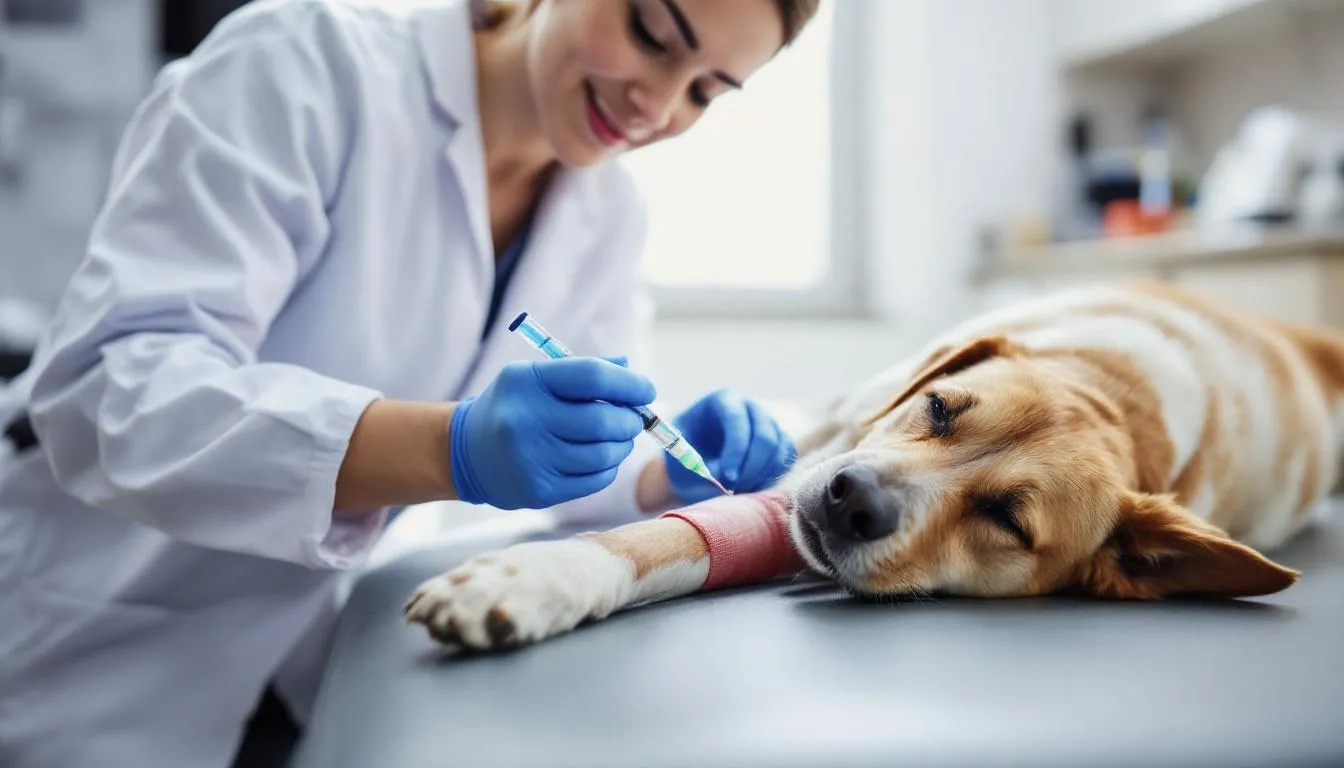

Key Takeaways
Von willebrand disease is the most common inherited bleeding disorder in dogs, caused by deficient or abnormal von willebrand factor protein
- Von willebrand disease is the most common inherited bleeding disorder in dogs, caused by deficient or abnormal von willebrand factor protein
- Doberman Pinschers are most affected with over 70% being carriers, though over 40 breeds can develop this condition
- The disease ranges from mild bleeding tendencies to severe life-threatening hemorrhages, with three distinct types (1, 2, and 3)
- Diagnosis involves blood tests measuring von willebrand factor levels and genetic testing, especially important before surgeries
- While incurable, the condition can be managed through careful monitoring, blood transfusions when needed, and responsible breeding practices
Doberman Pinschers are most affected with over 70% being carriers, though over 40 breeds can develop this condition
The disease ranges from mild bleeding tendencies to severe life-threatening hemorrhages, with three distinct types (1, 2, and 3)
Diagnosis involves blood tests measuring von willebrand factor levels and genetic testing, especially important before surgeries
While incurable, the condition can be managed through careful monitoring, blood transfusions when needed, and responsible breeding practices
When your dog experiences unexpected bleeding after a routine procedure, it could signal something more serious than a simple injury. Von willebrand disease in dogs represents the most common inherited bleeding disorder affecting our canine companions, impacting over 40 purebred dog breeds worldwide. This genetic condition disrupts normal blood clotting, potentially leading to excessive bleeding that ranges from mild inconvenience to life-threatening emergencies.
Understanding this condition becomes crucial for pet parents, especially those with high-risk breeds like Doberman Pinschers, where more than 70% may be carriers. While the prospect of an inherited bleeding disorder might seem daunting, many affected dogs live normal, healthy lives with proper management and veterinary care.
What is Von Willebrand Disease in Dogs?
Von willebrand disease represents an inherited bleeding disorder caused by deficiency or dysfunction of von willebrand factor (vWF), a critical protein essential for proper blood clotting. This glycoprotein serves dual purposes in maintaining hemostasis: it enables platelets to adhere properly at sites of blood vessel injury and acts as a carrier for clotting Factor VIII, supporting the normal blood clotting cascade.
When dogs lack adequate or functional von willebrand factor, their blood cells cannot form clots effectively at injury sites. This deficiency transforms minor cuts or surgical procedures into prolonged bleeding episodes. The condition follows an autosomal inheritance pattern, meaning both male and female dogs are equally affected, and dogs need only one copy of the defective gene to potentially express symptoms.
The prevalence of this common inherited bleeding disorder varies dramatically among dog breeds, with some populations showing carrier rates exceeding 70%. However, the genetic complexity means not every carrier will display clinical signs, making identification challenging without proper testing.
Unlike other bleeding disorders such as hemophilia, von willebrand’s disease primarily affects mucosal surfaces and superficial tissues rather than causing internal joint bleeding. This distinction helps veterinary medicine professionals differentiate between various clotting abnormalities during diagnosis.
Types of Von Willebrand Disease
Veterinary researchers have identified three distinct types of von willebrand’s disease in dogs, each characterized by different severities and protein abnormalities. Understanding these classifications helps predict disease progression and guides appropriate management strategies.
Type 1 represents the mildest and most common form, characterized by reduced levels of otherwise normal von willebrand’s factor. Dogs with this variant typically have 5-50% of normal vWF concentrations. Doberman pinschers predominantly develop this type, along with German shepherds, Standard Poodles, and Shetland Sheepdogs. Many affected dogs show minimal symptoms and may go undiagnosed until undergoing surgical procedures.
Type 2 involves both decreased levels and abnormal structure of the von willebrand factor protein. This severe form causes moderate to severe bleeding episodes and occurs most frequently in German Wirehaired Pointers and German Shorthaired Pointers. The structural abnormalities prevent the protein from functioning properly even when present in adequate quantities.
Type 3 represents the most severe form, characterized by virtual absence of von willebrand factor in the blood. Chesapeake Bay Retrievers and Scottish terriers show increased susceptibility to this devastating variant. Dogs with Type 3 disease face the highest risk of spontaneous bleeding and life-threatening hemorrhages.
Each dog breed typically develops one predominant type, though variations can occur within bloodlines. The correlation between type number and severity generally holds true, with higher-numbered classifications causing more severe bleeding problems and requiring more intensive management.


Affected Dog Breeds
Von willebrand disease affects an extensive range of purebred dogs, with prevalence varying significantly among breeds. Understanding breed-specific risks helps owners make informed decisions about testing and breeding programs.
Doberman pinschers lead the statistics as the most commonly affected breed, with studies indicating over 70% may be carriers or affected individuals. The average age of diagnosis in Dobermans occurs around four years, though many dogs remain asymptomatic throughout their lives. This high prevalence stems from historical breeding practices and the breed’s closed gene pool.
Other breeds predisposed to von willebrand’s disease include German shepherds, Scottish terriers, Bernese mountain dogs, and Golden Retrievers. Standard Poodles, Shetland Sheepdogs, Schnauzers, and various Pointer breeds also show elevated risk levels. Each breed tends toward specific disease types, with Chesapeake Bay Retrievers and Scottish terrier populations particularly vulnerable to the most severe form.
The genetic status varies even within affected breeds. While some bloodlines show concentrated disease inheritance, responsible breeding programs have successfully reduced incidence rates in certain populations. Many dog breeds maintain carrier frequencies around 20-30%, though clinical expression remains unpredictable due to incomplete penetrance.
Not all dogs within affected breeds will develop bleeding problems despite carrying disease genes. This variability complicates breeding decisions and emphasizes the importance of genetic testing rather than relying solely on clinical observations.
Clinical Signs and Symptoms
The clinical findings associated with von willebrand’s disease range from completely asymptomatic to life-threatening bleeding episodes. Recognition of these symptoms enables early intervention and appropriate management strategies.
Excessive bleeding represents the hallmark symptom, manifesting in various forms depending on disease severity. Spontaneous bleeding commonly occurs from mucous membranes, including nosebleeds, bleeding gums, bloody urine, or blood in feces. Many dogs experience prolonged bleeding after minor injuries, tooth loss during puppy development, or routine procedures like tail docking.
Trauma-related bleeding episodes often reveal the condition when dogs undergo surgery, giving birth, or experiencing accidents. Severely affected dogs may demonstrate uncontrollable bleeding following seemingly minor events, potentially leading to significant blood loss and anemia. Female dogs might show abnormal bleeding during heat cycles, while males may bleed excessively after neutering procedures.
The clinical signs can be subtle in mild cases. Some dogs show only occasional bruising or slightly extended bleeding times that owners might dismiss as normal variation. However, major surgical procedures often unmask hidden bleeding tendencies, making pre-surgical screening essential for at-risk breeds.
Many dogs diagnosed with von willebrand’s disease show no outward signs during routine activities. These asymptomatic carriers can still transmit the genetic defect to offspring, highlighting the importance of genetic testing in breeding programs regardless of clinical appearance.


Diagnostic Testing
Accurate diagnosis of von willebrand disease requires specialized blood tests that measure both protein levels and genetic status. Early detection proves crucial for surgical planning and breeding decisions.
The primary diagnostic tool involves the von willebrand factor antigen assay (VWF:Ag), which measures plasma vWF concentration. This blood test provides quantitative assessment of protein levels, with results typically expressed as percentages of normal values. Dogs with VWF:Ag below 50% face increased risk of expressing bleeding symptoms or transmitting the disease to offspring.
Genetic testing using DNA analysis offers definitive identification of disease status regardless of protein levels. These genetic tests utilize blood samples or cheek swabs to detect specific mutations associated with all three types of von willebrand’s disease. The testing proves particularly valuable for identifying carriers who may have normal or borderline protein levels.
The buccal mucosal bleeding time serves as a functional screening test, measuring how long it takes for bleeding to stop after a standardized oral incision. While useful for initial assessment, this test lacks the specificity needed for definitive diagnosis and may miss mild cases.
Additional diagnostic tools include complete blood counts, chemistry panels, and coagulation profiles to rule out other bleeding disorders. Platelet function tests may help differentiate von willebrand’s disease from other causes of abnormal bleeding, though normal platelet counts typically accompany vWD.
Testing considerations include timing and patient condition. Results prove most reliable when dogs are healthy, not pregnant, and not in heat, as these conditions can artificially alter protein levels and complicate interpretation.
Treatment Options
While no cure exists for this genetic condition, several treatment modalities help manage bleeding episodes and reduce complications. Treatment approaches focus on controlling acute bleeding and preventing future incidents.
Emergency treatment for severe bleeding episodes involves blood transfusions using fresh frozen plasma or specialized blood products containing von willebrand factor. These transfusions provide immediate hemostatic support during life-threatening hemorrhages but offer only temporary improvement lasting 12-24 hours.
DDAVP (desmopressin acetate), a hormone called ddavp, can temporarily increase von willebrand factor levels in some dogs, particularly those with Type 1 disease. This medication triggers sudden release of stored vWF from blood vessel walls, potentially doubling protein levels within 30 minutes. However, response rates vary among individuals, and the effect diminishes with repeated use.
Preventive measures include pre-surgical plasma transfusions or DDAVP administration to minimize hemorrhage risks during planned procedures. Testing clotting ability prior to surgery helps determine appropriate prophylactic measures for individual dogs.
Medication management requires careful consideration, as certain medications can worsen bleeding tendencies. Owners must avoid aspirin, sulfa antibiotics, heparin, and other drugs that interfere with platelet function or blood clotting factors. Always consult veterinary professionals before administering any medications to affected dogs.
Supportive care tailored to individual severity levels forms the cornerstone of long-term management. Most dogs require minimal intervention beyond awareness and precautionary measures during high-risk situations.


Management and Prevention
Successful management of von willebrand’s disease combines lifestyle modifications, careful monitoring, and strategic breeding practices. Most affected dogs can maintain excellent quality of life with appropriate precautions.
Lifestyle modifications focus on preventing situations that might trigger bleeding episodes. Avoid rough play, minimize stress exposure, and monitor for any signs of bleeding or unusual bruising. Dogs suspected of having the condition should avoid activities with high injury risk until testing confirms their status.
Communication with veterinary staff proves essential for safe medical care. Inform all veterinary medicine professionals about your dog’s condition before any procedures, ensuring appropriate precautions and treatment modifications. This includes routine dental cleanings, vaccinations, and emergency treatments where bleeding risks might increase.
Stress management plays an important role, as emotional stress may trigger bleeding episodes in susceptible dogs. Maintain predictable routines, provide secure environments during travel, and consider anti-anxiety measures during unavoidable stressful events.
Breeding programs should prioritize genetic testing and responsible selection practices. Avoid breeding affected dogs or carrier-to-carrier matings to reduce disease transmission. Many breed organizations recommend testing all breeding candidates and making results publicly available.
Regular monitoring includes observing for bleeding signs, especially during heat cycles, minor injuries, or dental issues. Document any unusual bleeding episodes with photos or videos to help veterinarians assess severity and adjust management strategies.
Prognosis and Life Expectancy
The prognosis for dogs with von willebrand disease varies considerably depending on disease type, individual severity, and management quality. Understanding realistic expectations helps owners make informed care decisions.
Dogs with mild cases often live completely normal lifespans without significant complications. Many affected dogs never experience serious bleeding episodes, particularly when owners maintain appropriate precautions and veterinary awareness. Type 1 disease typically offers the most favorable outlook, with most dogs requiring minimal intervention.
Severely affected dogs face increased risks of life-threatening bleeding episodes, particularly during surgeries, trauma, or spontaneous hemorrhage events. However, with proper emergency preparedness and veterinary support, even dogs with severe forms can achieve good quality of life outcomes.
The key to successful long-term management lies in early recognition, appropriate testing, and proactive planning. Dogs diagnosed early and managed properly show significantly better outcomes than those identified only after serious bleeding incidents.
Regular veterinary monitoring becomes essential for tracking disease progression and adjusting management strategies. Some dogs may experience changes in bleeding tendencies over time, requiring modified approaches to care and prevention.
Most dogs adapt well to necessary lifestyle modifications, and owners often report minimal impact on daily activities once appropriate precautions become routine. The condition rarely prevents dogs from enjoying normal companionship, exercise, and family life.
FAQ
Can von willebrand disease be cured in dogs?
No, von willebrand disease cannot be cured as it is a genetic condition present from birth. However, it can be effectively managed through proper veterinary care, lifestyle modifications, and emergency preparedness. Most dogs with mild to moderate forms live normal, healthy lives with appropriate precautions and treatment when needed.
Should I test my healthy Doberman for von willebrand disease?
Yes, testing is strongly recommended for Dobermans, especially before any surgical procedures including spaying or neutering. With over 70% of Dobermans being carriers or affected, many show no symptoms until undergoing surgery. Genetic testing helps identify status regardless of symptoms and enables breeders to make informed breeding decisions to reduce disease transmission.
What medications should I avoid giving my dog with von willebrand disease?
Avoid medications that interfere with blood clotting, including aspirin, sulfa antibiotics, heparin, and non-steroidal anti-inflammatory drugs unless specifically prescribed by your veterinarian. Always consult your veterinary team before administering any new medications, supplements, or over-the-counter treatments to ensure they won’t increase bleeding risk or interact with your dog’s condition.
How much does genetic testing for von willebrand disease cost?
Genetic testing typically costs between $50-150 for individual tests, though prices vary by laboratory and testing panel. Many comprehensive genetic health panels include von willebrand disease testing alongside other inherited conditions, often providing better value. Some breed organizations offer discounted testing for members, making screening more accessible for responsible breeding programs.
Can dogs with mild von willebrand disease undergo routine surgeries safely?
Yes, dogs with mild forms can safely undergo necessary surgeries with proper preparation and veterinary supervision. This may include pre-surgical blood testing, DDAVP treatment, plasma transfusions, or having blood products available during procedures. The key is informing your surgical team about the condition so they can take appropriate precautions and be prepared for any complications.
FAQ
Can von willebrand disease be cured in dogs?
No, von willebrand disease cannot be cured as it is a genetic condition present from birth. However, it can be effectively managed through proper veterinary care, lifestyle modifications, and emergency preparedness. Most dogs with mild to moderate forms live normal, healthy lives with appropriate precautions and treatment when needed.
Should I test my healthy Doberman for von willebrand disease?
Yes, testing is strongly recommended for Dobermans, especially before any surgical procedures including spaying or neutering. With over 70% of Dobermans being carriers or affected, many show no symptoms until undergoing surgery. Genetic testing helps identify status regardless of symptoms and enables breeders to make informed breeding decisions to reduce disease transmission.
What medications should I avoid giving my dog with von willebrand disease?
Avoid medications that interfere with blood clotting, including aspirin, sulfa antibiotics, heparin, and non-steroidal anti-inflammatory drugs unless specifically prescribed by your veterinarian. Always consult your veterinary team before administering any new medications, supplements, or over-the-counter treatments to ensure they won’t increase bleeding risk or interact with your dog’s condition.
How much does genetic testing for von willebrand disease cost?
Genetic testing typically costs between $50-150 for individual tests, though prices vary by laboratory and testing panel. Many comprehensive genetic health panels include von willebrand disease testing alongside other inherited conditions, often providing better value. Some breed organizations offer discounted testing for members, making screening more accessible for responsible breeding programs.
Can dogs with mild von willebrand disease undergo routine surgeries safely?
Yes, dogs with mild forms can safely undergo necessary surgeries with proper preparation and veterinary supervision. This may include pre-surgical blood testing, DDAVP treatment, plasma transfusions, or having blood products available during procedures. The key is informing your surgical team about the condition so they can take appropriate precautions and be prepared for any complications.






